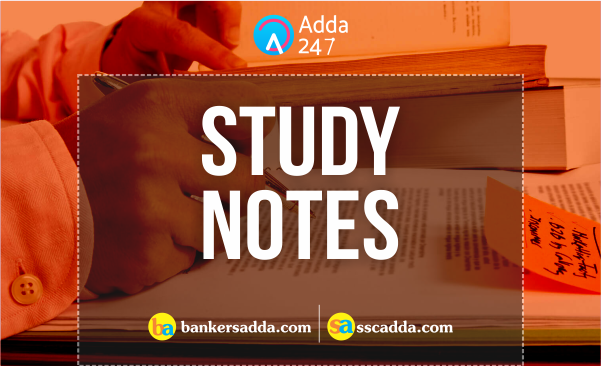Dear Aspirants,
Reasoning Ability Study Notes for Bank and Other Competitive Exams
Study Notes is an effective strategy that helps you to learn about the subject. This will not only help you to learn effectively but it will also play a crucial role during last minute quick revision.
1) > ≥ =
Eg. :–
Statement: P=Q=R≤W<V
Example: – A © B means ‘A’ is smaller than ‘B’
Inequalities is one of the topic where you can get full marks very easily. It is a common topic for all competitive exams. We can expect 3 to 5 questions from Inequality.
Before discussing details for solving Inequalities questions, lets check the meaning of certain symbols in below table:–
To check the different relationship, we are presenting some different statement and conclusions in below table. From given below table you will get clear concept of relationship between two letters.
Priority of Symbols:
1) > ≥ =
For ex- If T>P≥Q=R
Then, T> Q and T>R
2) < ≤ =
For ex- If W<X≤V=Y
Then, W<Y and W<V
3) > < (No relation)
For ex- If Q>K<L
Then there will be no relation between Q and L.
4) > ≤ (No relation)
For ex- If O>J≤H
Then there will be no relation between O and H.
5) < > (No relation)
For ex- If F<E>Q
Then there will be no relation between F and Q.
6) < ≥ (No relation)
For ex- If D<S≥Z
Then there will be no relation between D and Z.
Either- or case: In equality it is very important condition. Mostly students make mistakes in this condition. For clear concept we are giving example of “either-or”
1st condition for “either-or” is both conclusions should be wrong.
2nd condition is that variables of both conclusions should be same.
Eg. :–
1. Statement: A≥B=C
Conclusion: (a) A > C(not true) (b) A = C (not true)
In above example, relation between A and C is A≥C. But both the conclusions are wrong and both have same variables. And by combining both conclusions you will get the actual relation between A and C which comes from statement.
2. Statement: P=Q≥R≥S=T
Conclusion I: (a)P>T (b)P=T
From the above statement it is clear that P is either equals to T or P is greater than T ,So individually both the conclusions are wrong but by combining them we will get that P is either greater than or equals to T (P≥T).
Conclusion II: (a) Q>S (b) Q=S
Similarly from the above statement for conclusion II we can see that there is an either / or case between Q and S, So Q either will be greater than or equals to S.
The complicated case of “Either-or” :
Statement: H≥M≤V=K
Conclusions: (1) H<K(not true) (2) H≥K(not true)
In the above statement we cannot find the relation between H and K. There may be three possibilities of relation between H and K.
i.e. (a) H>K (b) H<K (c) H=K
And we are getting all possibilities by combining both conclusions. So, this is also one case of “Either-or”.
Statement: F<T≤N,F>S,M≤T<G
Conclusions: I.M≥S II. S>M
In the above question by combining the statements together we get S<F<T≥M. So we cannot find the relation between M and S. As there can be three possible cases: M is either greater, lesser or equals to S. In conclusions I and II we can find all the three possible cases so the answer will be either conclusion I or II follow.
Statement: L≥K<E≥A>F≥B
Conclusions: I.L<B II.B≤L
This is another example showing that no direct relation is found between B and L and all the three possible conditions as L>B, L<B or L=B can be there. So the answer will be either conclusion I or II follow.
Questions based on inequality are of two types:–
(1) Direct Inequality
(2) Indirect Inequality
1. Direct Inequality: In this type, relationship symbols between variables are given indirect form.
Example:–
Statement: A=B≥C<D=E≤F
Conclusion: (a) F>B(not true) (b) B≥D(not true)
Here, both conclusion (a) and (b) does not follow. As there is relation between F and B, B and D.
And here, variables of both conclusions are different
So, there will no “either-or” case.
Statement: P>M>Q≥Z>N
Conclusions: (a) Q>N(true) (b) P>N(true)
Statement: X>Y=Z>V<W
Conclusions: (a) Y=V(not true) (b) X>V(true)
Here, conclusion (a) is wrong as Y is greater than V and conclusion (b) is right.
Statement: P=Q=R≤W<V
Conclusions: (a) Q≤W(true) (b) R≤V(not true)
Here, Conclusion (a) is right and (b) is wrong because R will be less than V (R < V).
Statement: H>M<Q≥R>X<Y
Conclusions: (a) M>R(not true) (b) M≤R(not true)
Here both conclusions are wrong but variables are same. And by combining both conclusions we are getting all three possibilities of relation between M and R. So, here answer will be either conclusion (a) or (b) follows.
2. Indirect Inequalities: In this type, relationship symbols between variables are given in coded form.
Example : – A © B means ‘A’ is smaller than ‘B’
A # B means ‘A’ is greater than ‘B’
A % B means ‘A’ is either smaller than or equal to ‘B’
A $ B means ‘A’ is either greater than or equal to ‘B’
A @ B means ‘A’ is neither smaller than nor greater than ‘B’
Statement: V # S, S © L, L © J
Conclusion: I. V © L II. S © J
For solving coded inequalities, there is one method to decode all coded symbol and decode symbols between statement and conclusion and then check the relationship between variables. But this method is lengthy. And each second is important for students during exam.
So, we are presenting magic box trick to solve these type of questions in less time.
We will divide box in two groups (1) and (2)
Now we are taking an example of Indirect inequality and will explain this magic box trick.
Example: – A © B means ‘A’ is smaller than ‘B’
A # B means ‘A’ is greater than ‘B’
A % B means ‘A’ is either smaller than or equal to ‘B’
A $ B means ‘A’ is either greater than or equal to ‘B’
A @ B means ‘A’ is neither smaller than nor greater than ‘B’
Statement: V # S, S © L, L © J
Conclusions: (i) V © L (ii) S © J
Steps to apply Magic for trick :–
1. First of all we will draw a rectangular box and place all different symbols of inequalities.
2. Now, we decode given information and place that particular code at different symbols place in a rectangular box.
Remember one thing that we can compare variables with same group of coded symbols
i.e. we cannot compare # and © or $ and %.
3. Now we will try to solve the question as in conclusions
I. it is asked V © L ?
As in statement it is given V # S, S © L
So, we cannot compare # and © as they belongs to different group.
And in conclusion II. It is asked S © J ?
And is statement it is given S © L, L © J
So, S © J is correct.
Example – 2:–
Statement : M # R, R $ J, J @ H
Conclusion: I. M # J II. R $ H
As in conclusions I. It is asked M # J ?
So, we will the find the relation between M and J and we have to compare # and $. And according to Magic box # and $ belongs to same group and priority of # is more than $.
So, conclusions I. is correct.
And in conclusions II. We have to find relation between R and H and for this we have to compare $ and @ and according to magic box $ and @ belongs to same group and priority of $ is more than @
So, Conclusions II. Is correct.
We have tried our best to give clear and detail concept of Inequalities. Hope you will be able to get it and can solve must do questions of Inequalities in less time.
We have given our best to make you understand the concept of “Inequalities” with some different examples with their explanation. Hope you will be able to get things clear.






 GA Capsule for SBI Clerk Mains 2025, Dow...
GA Capsule for SBI Clerk Mains 2025, Dow...
 The Hindu Review October 2022: Download ...
The Hindu Review October 2022: Download ...
 Central Bank Credit Officer Recruitment ...
Central Bank Credit Officer Recruitment ...





